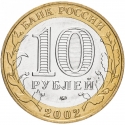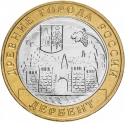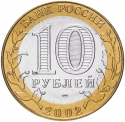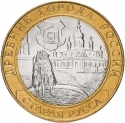You are about to finish your registration. Please check your mailbox (including spam folder). There should be a letter with a confirmation link. Check setting to make sure that your e-mail address is correct.
Send letter againDescription
In 2002 the Central Bank of the Russian Federation began an annual program that each year commemorates some of their historical towns on bi-metallic 10 Ruble coins. The coins picture the city and its arms on one side and has the standard Russian 10 Ruble obverse on the other. Unlike a lot of coin programs throughout the world there is no set regularity to the number of coins released each year in this series, with some years seeing 4 coins issued and other years only 3.
Pskov is a city located in the north-western part of European Russia, at the confluence of the Velikaya and the Pskova rivers, the capital of the Pskov region. It is one of the most ancient Russian cities.
Pskov is one of the oldest cities in Russia. The name of the city, originally spelled "Pleskov", may be loosely translated as "purling waters". Its earliest mention comes in 903, which records that Igor of Kiev married a local lady, St. Olga. In the 12th and 13th centuries, the town adhered politically to the Novgorod Republic. In 1241, it was taken by the Teutonic Knights, but Alexander Nevsky recaptured it several months later during a legendary campaign dramatized in Sergei Eisenstein's 1938 movie.
By the 14th century, the town functioned as the capital of a de facto sovereign republic. For Russia, the Pskov Republic was a bridge towards Europe; for Europe, it was a western outpost of Russia. The importance of the city made it the subject of numerous sieges throughout its history. The Pskov Krom (or Kremlin) withstood twenty-six sieges in the 15th century alone. Finally, in 1510, the city fell to Muscovite forces. The deportation of noble families to Moscow is a subject of Rimsky-Korsakov's opera Pskovityanka (1872). As the second largest city of the Grand Duchy of Moscow, Pskov still attracted enemy armies. Most famously, it withstood a prolonged siege by a 50,000-strong Polish army during the final stage of the Livonian War (1581–1582). The king of Poland Stephen Báthory undertook some thirty-one attacks to storm the city, which was defended mainly by civilians. Even after one of the city walls was broken, the Pskovians managed to fill the gap and repel the attack.
Peter the Great's conquest of Estonia and Latvia during the Great Northern War in the early 18th century spelled the end of Pskov's traditional role as a vital border fortress and a key to Russia's interior.
Issue date: 25.02.2003
Obverse

|
Depicts the inscriptions along the circumference BANK OF RUSSIA at the top and date at the bottom. There are images of branches of the bay tree and oak tree on the left and on the right of the outer ring, respectively, their elements extending onto the disc. The number ‘10’ and the inscription RUBLES below denoting the face value of the coin are in the centre of the disc. The digit ‘0’ features a security element inside in the form of the figure ‘10’ and the inscription RUB visible at various viewing angles to the coin surface. The Saint Petersburg Mint trademark is at the bottom of the disc. БАНК РОССИИ |
|---|---|
Reverse

|
Depicts the image of the Pskov Kremlin on a riverside, the coat of arms of the city of Pskov above, over it on a ribbon the semicircular inscription: ANCIENT TOWNS OF RUSSIA, below the inscription along the rim PSKOV. ДРЕВНИЕ ГОРОДА РОССИИ |
| Edge |
300 corrugations and the inscription ДЕСЯТЬ РУБЛЕЙ (TEN RUBLES) recurring twice and divided by asterisks ДЕСЯТЬ РУБЛЕЙ ⋆ ДЕСЯТЬ РУБЛЕЙ ⋆ |
10 Rubles
Y# 800 Schön# 757 CBR# 5514-0016
Characteristics
| Type | Commemorative Issue (Circulating) |
| Material | Bi-Metallic |
| Ring | Brass |
| Center | Cupronickel |
| Weight | 8.4 g |
| Diameter | 27 mm |
| Thickness | 2.1 mm |
| Shape |
|
| Alignment | Medal |
| Mint |
Saint Petersburg Mint (SPMD)
|







